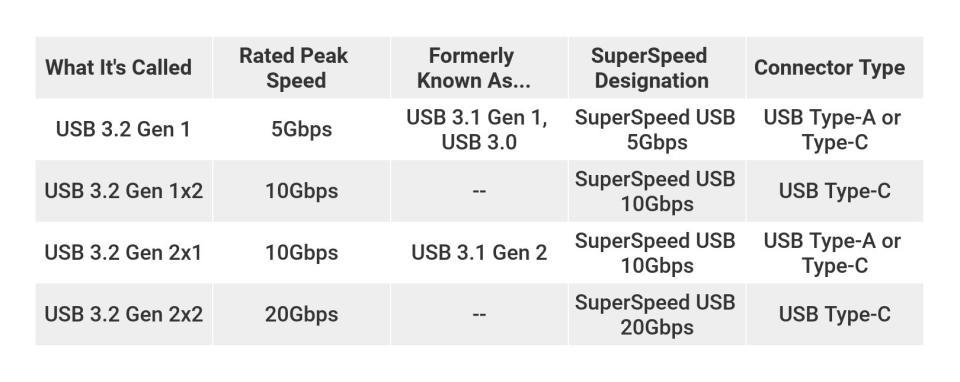In the world of personal electronics, settling on a single standard to rule them all is a lofty goal. At best, you’ll find yourself in a format war, with one group emerging victorious for a few years until a whole new technology eliminates it. VHS ate Betamax, then DVD, which faded in the face of Blu-ray (which knocked off its major rival, HD DVD), and is now facing its own demise at the hands of Internet streaming services.

But USB-C and USB 3.2 Gen 1×2 and USB 3.2 Gen 2×2 all are different, and its moniker (Universal Serial Bus) emphasizes that it is genuinely universal. USB Type-C connections may now be found on a wide range of devices, ranging from simple external hard drives to high-end laptops and the most recent smartphones. While every USB-C port appears to be the same, not all of them have the same features. Although USB-C is now widely used, it does not perform the same functionalities everywhere. By a long shot, no.
Here’s a rundown of what USB-C can achieve and which characteristics to look for when purchasing your next USB-C gadget.
What Is USB-C? How it is connected to USB 3.2 Gen 1×2 and USB 3.2 Gen 2×2? Can c type to micro USB possible? Which hardware part of intel is dubbed as USB C?
EVERYTHING IS ANSWERED BELOW.
Which hardware part from intel is dubbed as the USB c? The USB-C connector is an industry standard for delivering data and power over a single wire. The USB Implementers Forum (USB-IF), a consortium of firms that has developed, certified, and shepherded the USB standard over the years, created the USB-C connector. Apple, Dell, HP, Intel, Microsoft, and Samsung are among the more than 700 companies that make up the USB-IF.
This broad support by the big dogs is critical, as it explains why PC manufacturers have been so quick to embrace USB-C. In comparison, the prior Apple-promoted (and developed) Lightning and MagSafe ports had limited adoption outside of Apple products and eventually became obsolete owing to USB-C.
Is USB-C the same as Micro USB? How it is connected to USB 3.2 Gen 1×2 and USB 3.2 Gen 2×2?
At first glance, the USB-C connector resembles a micro USB connector, but it’s oval in shape and slightly thicker to accommodate its main feature: flippability. and the answer for c type to micro USB possible, how it is connected to USB 3.2 Gen 1×2 and USB 3.2 Gen 2×2?
The USB-C connector, like Lightning and MagSafe, has no up or down orientation. You’ll never have to flip the connector over to plug it in if you line it up correctly; the “right way” is always up. Standard cables also feature the same connector on both ends, eliminating the need to figure out which end belongs where. That hasn’t always been the case with all of the USB cords we’ve used over the last two decades. The majority of the time, each end has a distinct connector. peoples often ask if C type to micro USB possible
The Numbers Beneath the Port: USB-C and USB 3.2 Gen 1×2 and USB 3.2 Gen 2×2 | Which hardware part from intel is dubbed as the usb c?
The numbers that are assigned to the ports are where USB-C and USB 3.2 Gen 1×2 and USB 3.2 Gen 2×2 get difficult. The most popular USB-C connector speed is 10 Gigabits per second. (The 10Gbps transfer rate is theoretically twice as fast as USB 3.0.) “USB 3.2 Gen 1×2” refers to USB-C ports that handle this maximum speed.
The only snag is that USB ports with 10Gbps speeds can be found in the original, larger design (the USB Type-A rectangles we’re all familiar with) and are referred to as “USB 3.2 Gen 1×2.” Except for a few PCs, 10Gbps USB ports with Type-C physical connectors are becoming more widespread. Note that some earlier USB-C ports only support 5Gbps transfers; therefore, seek a “USB 3.2 Gen 1×2” or “10Gbps” certification to ensure that a USB-C port can handle 10Gbps data. However, all of these ports are backward compatible, but only to the speed of the slowest piece.
Are you puzzled yet? Complicating issues even more: Since 2019, the numbering method for USB 3 has been in flux, making references to these ports a bit of a muddle. Until last year, several USB-C ports in Gen 1 and Gen 2 variants carried the USB 3.1 label (“USB 3.2 Gen 1×2” was not yet a thing), and several spec sheets still refer to the older moniker, along with SuperSpeed branding. In an unexpected turn of events, the USB-IF chose to phase out the use of “USB 3.1” in favor of these many varieties of USB 3.2 Gen 1×2 and USB 3.2 Gen 2×2, as seen in this handy decoder chart…

The USB 3.2, USB 3.1, and SuperSpeed designations on each line are all the same, with the exception of the names. If you notice a USB 3.1 label, contact the device manufacturer or reseller directly to find out what the port’s maximum transfer speeds are. How it is connected to USB 3.2 Gen 1×2 and USB 3.2 Gen 2×2?
Some USB-C connectors, as seen above, use the USB 3.2 Gen 2×2 specification, which has a maximum speed of 20GBps. Because this standard doubles the data lanes within a USB-C connection to reach the 20Gbps transfer speed, the USB-IF chose “USB 3.2 Gen 2×2.” These ports aren’t widely available, however, they can be found on some high-end desktop motherboards for PC builders and upgraders. As 2021 proceeds, they will most likely be phased out in favor of a new type of USB-C port that supports USB4 (more about which in a moment).
The Many Roles of USB-Underlying C’s Support ,Which hardware part of intel is dubbed as USB C?
Your old USB Type-A port may be thought of solely as a data port for attaching drives or devices such as mice. However, depending on how the connector is implemented, USB-C can accomplish a lot more. When constructed correctly, one of USB-most C’s valuable abilities is to transmit enough power to charge the host device, such as a laptop or smartphone. In fact, many lightweight laptops with USB-C ports use them as the only option for connecting an AC adapter instead of a classic barrel-style connector.

Because USB-C can deliver video and power at the same time, you might be able to connect to and power a native DisplayPort, MHL, or HDMI device, or connect to nearly anything else if you have the right adaptor and cables. (For further information about adapters, see the section below.) Although the USB-C specification includes audio transmissions over the interface, it has yet to completely replace the 3.5mm headphone jack on computers, as it has on phones and tablets.
Check the specifications of any PC you’re considering purchasing, as not all USB-C ports are created equal. Every one we’ve seen so far supports data transfers as well as connected-device power delivery through USB-C. (though not necessarily charging of the host device). However, while the USB-C standard allows you to connect DisplayPort and/or HDMI monitors to your computer via an adaptor (through the DisplayPort-over-USB protocol), not every PC manufacturer has connected the connections to their graphics hardware. Some USB-C ports on a machine may enable video output, while others do not; or none at all. It’s crucial to pay attention to the nuances.
Thunderbolt 3 and 4 on USB-C: Adding Even More Speed, Can c type to micro USB possible?| Which hardware part from intel is dubbed as the usb c?
Thunderbolt 3, or the upcoming Thunderbolt 4, Which hardware part of intel is dubbed as USB C? Thunderbolt 3 so it is perhaps the most beneficial protocol that a USB-C connector can offer. Either one offers up to 40Gbps of speed, as well as lower power consumption and the capacity to transport up to 100 watts of power through the interface.
A USB-C connector with Thunderbolt 3 or 4 capability implies that all you need is a single cable to push power and transfer a significant quantity of data (up to and including video data for two 60Hz 4K monitors) to and from even a complicated device like a computer, which many laptop manufacturers have jumped on. Apple’s MacBook Pro models include as many as four Thunderbolt 3 connectors, which is the most we’ve seen so far, and it gives you more extension potential than previous versions of USB.
Similarly to DisplayPort over USB-C, not every USB-C connector you encounter will support Thunderbolt 3 or 4. To be sure, look for Thunderbolt details on a device’s spec sheet or literature. Some products may have many USB-C ports, however only a few support the Thunderbolt standard.
With the USB4 standard, the Thunderbolt uncertainty will be resolved. USB4 connections, which have only recently begun to appear on a few laptops in early 2021, enable Thunderbolt 3 speeds by default while still being backwards compatible with USB 3, USB 3.1, USB 3.2 Gen 1×2, USB 3.2 Gen 2×2. They share the same physical connector shape as the USB-C standard.
Then there’s Thunderbolt 4, which has recently been seen in some PCs. For most users, it doesn’t offer any significant advantages to Thunderbolt 3, and the two protocols appear to be very similar at first glance. Both use the USB Type-C physical connector and have a maximum throughput of 40 Gigabits per second, so speed isn’t an issue. Both have a charging power of at least 15 watts and up to 100 watts.
Thunderbolt 4 advances Thunderbolt by doubling the minimum visual and data requirements from Thunderbolt 3. Thunderbolt 4 will be able to send video to two 4K monitors or one 8K display, but Thunderbolt 3 will only be able to handle one 4K display. Thunderbolt 3 systems must also support a 16Gbps data throughput over PCI Express, but Thunderbolt 4 will quadruple that to 32Gbps. Users who frequently transfer large video or data files from storage drives to their PC for editing may find this useful.
Cables and Adapters, Which hardware part of intel is dubbed as USB C?|Which hardware part from intel is dubbed as usb c?
Thunderbolt 3, or the upcoming Thunderbolt 4
Older USB 3.0 ports are electrically compatible with USB-C. If you want to connect anything that doesn’t have the USB-C oval shape, you’ll need adapters or cables with proper connectors due to the changed shape of the port.

These are sometimes included with new laptops; in other cases, you may need to purchase them separately. Apple, for example, supplies USB cables and adapters for connecting USB-C to other technologies like Lightning and Ethernet. If you look through online retailers, you can find a variety of these for PCs. Some even support older or obscure protocols, ensuring that a device you bought years ago will work with today’s hardware. For example, USB-C to DVI adapters are widely available, but we’ve also seen some that split into two RS-232 serial connections.
The good news is that a couple of standard USB-C cables will work with anything that supports USB-C, regardless of generation. It should be noted, however, that this does not apply to Thunderbolt. Despite the fact that Thunderbolt 3 and 4 use the same physical connector as USB-C, you’ll need a Thunderbolt-specific cable to ensure compatibility and full speed. Both ends of this cable will have a USB-C connector, but each will have a lightning symbol on it. It’ll also be a lot more expensive than a standard USB-C cable. For more information on the cable issues, see our Thunderbolt 4 primer.
Furthermore, USB-C is now widely integrated in newer docks for PCs and Macs. It’s not a problem if you only have one USB-C port: USB-C docking solutions are available from both PC manufacturers like Dell and HP and third-party accessory makers like Belkin and OWC. These docks can charge your laptop, provide additional ports (such as Ethernet, HDMI, USB 3.0, and VGA), and allow you to connect multiple monitors.
Is USB-C Necessary? And Which hardware part of intel is dubbed as USB C?
When purchasing a computer, the presence (or absence) of a USB-C port is becoming increasingly important. If you purchase an ultrathin laptop, it will almost certainly include at least one USB-C port, which will automatically integrate you into the ecosystem. If you prefer desktops, you’ll find the ports there as well, with at least one on the motherboard’s I/O panel and likely more on high-end and gaming machines. One can also be found on the front panel of some desktops and aftermarket PC cases.
Even if you don’t need USB-C right now, you will in the near future. We’ve only scratched the surface of what USB-C can do, but one thing is certain: the next generation of cross-platform connectors is rapidly replacing the old guard, just as the original USB standard did for Apple Desktop Bus (ADB), FireWire, parallel, PS/2, SCSI, and serial ports on Macs and PCs. USB-C truly is the port to end all ports.
Also Read

